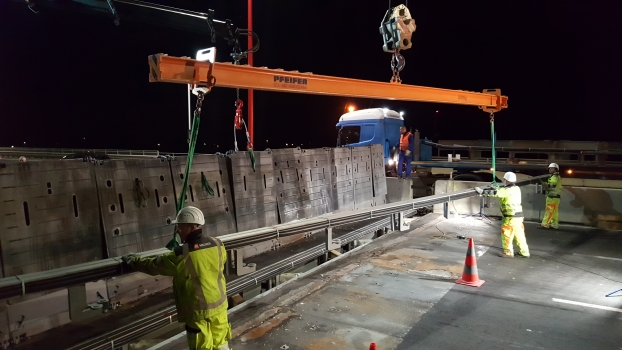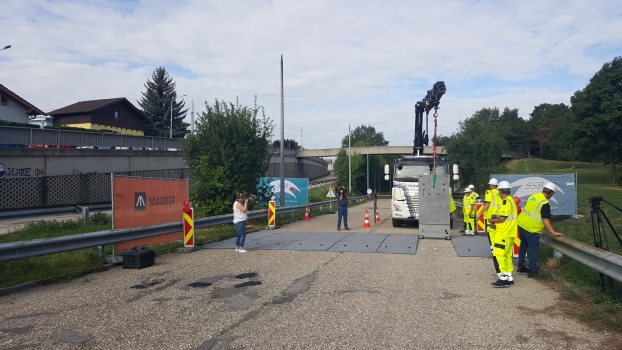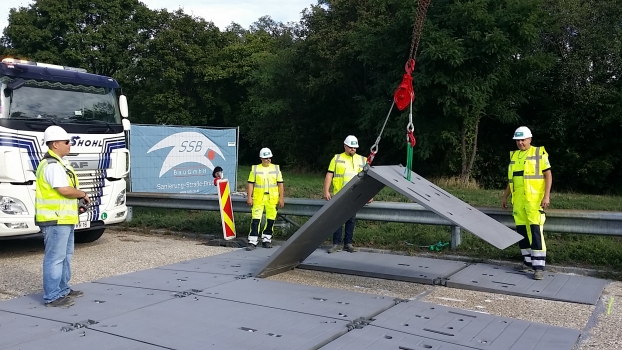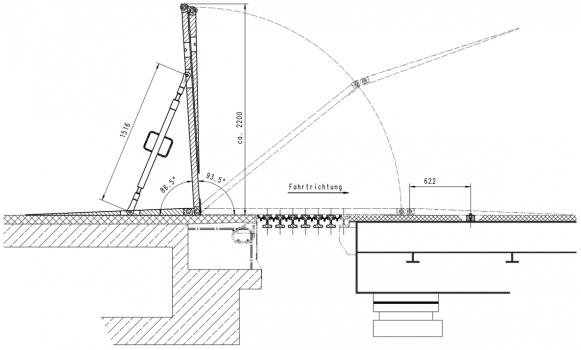Replacement of expansion joints in just 45 minutes
The replacement of all movable expansion joint parts of the Prater Bridge, the most frequented road bridge in Vienna, was executed without the full closure of the affected motorway.
Media
The police had to stop traffic only three times for 15 minutes to lift the central supports of the new expansion joints into position on the four-lane A23 highway bridge. The only way to adhere to the ambitious time schedule was the use of MMBS (MAURER Modular Bridging System). The bridging system had been tested by the client, ASFINAG (Autobahn- und Schnellstraßenfinanzierung AG), prior to its first deployment on an Austrian highway.
With 220,000 vehicles per day on average, the Prater Bridge as a section of the south-east expressway Vienna (A23) is the busiest highway bridge in Austria. Now the expansion joints (MAURER DS420) on the four-lane bridge have to be partially renewed. The expansion joint replacement in southern direction was done in September/October 2019. The expansion joints in northern direction are scheduled by ASFINAG starting in April 2020.
The challenge was to organize the reconstruction without considerable traffic impairment. During the day, traffic had to continue on four lanes, and even at night, no full closure had been approved. The official authorization said that the police could stop traffic for 15 minutes at most. Within these extremely short timeframes, the constructional measure, which is complex both in terms of technology and logistics, had to be completed – with high employment of staff and machines on an extremely confined construction site.
MMBS used on an Austrian highway for the first time
In order to achieve this goal, the modular MMBS bridging system was used on an Austrian highway for the first time. Since the steel support structure of the bridge features a very low pavement joint height of approx. 60 mm, a large fly-over solution was not possible: the elements could not be anchored in the area of the Prater Bridge. For a friction-type anchoring of the MMBS elements on the steel support structure of the bridge, a special solution could be developed.
For lack of previous experiences, ASFINAG tested the step-by-step assembly and disassembly as well as the unfolding and folding of the MMBS elements in a test environment jointly with the local construction supervision agency and the executive construction company. The decisive factors were, on the one hand, the time needed, and, on the other hand, the roadworthiness. Crossing traffic with up to 80 km/h as well as braking and starting were tested. After the internal test, a broadcast was arranged to demonstrate the function of the MMBS plates.
An MMBS element basically consists of three steel plates. The two ramp elements and the center plate are interconnected by joints. For work on the construction site, the center plate is lifted by a loading crane, the ramp element on the exit side is folded downwards, and both are vertically secured.
The elements weighing approx. 3 t are placed next to each other onto the work area, fastened, and then can be crossed even by heavy traffic. For the four lanes (14 m) on the Prater Bridge, 11 MMBS elements were used, which were placed and anchored in a single night.
15 minutes: disengage, unfold, fasten, lift into position, relocate, disengage, close, fasten
The building site was established in early September, the disassembly of the expansion joints commenced in mid-September. The complete “interior” of the old expansion joint was removed step by step at night: 6 center supports with a length of approx. 16 m as well as all related parts like crossbeams, bearings, seals and spring packages. What remained in place were only the edge constructions firmly connected to the structure. During this work, the bridge could be crossed on at least one lane also between midnight and 5 a.m.
The 6 new center supports were then lifted into position in the night of September 25/26, two center supports at a time since more was not possible for load reasons. What was done during this night from 10 p.m. to 5 a.m. was a technical and logistic masterpiece and had been planned and coordinated in detail with all stakeholders beforehand.
Actually, the traffic was stopped three times for 15 minutes as predetermined. Within these short timeframes, the MMBS were disengaged, unfolded and secured, a pair of center supports was lifted into position and relocated, and the MMBS disengaged again, closed, and secured.
The partial renewal of the expansion joints by MAURER lasted about 5 weeks, the total construction site two and a half months. A key success factor for this challenging reconstruction project was the constructive collaboration within the MAURER Group and with the client (ASFINAG), the construction supervision agency (Pöyry) and the building company (SSB - Sanierung Straße Brücke Bau GmbH).





 MAURER SE
MAURER SE 
